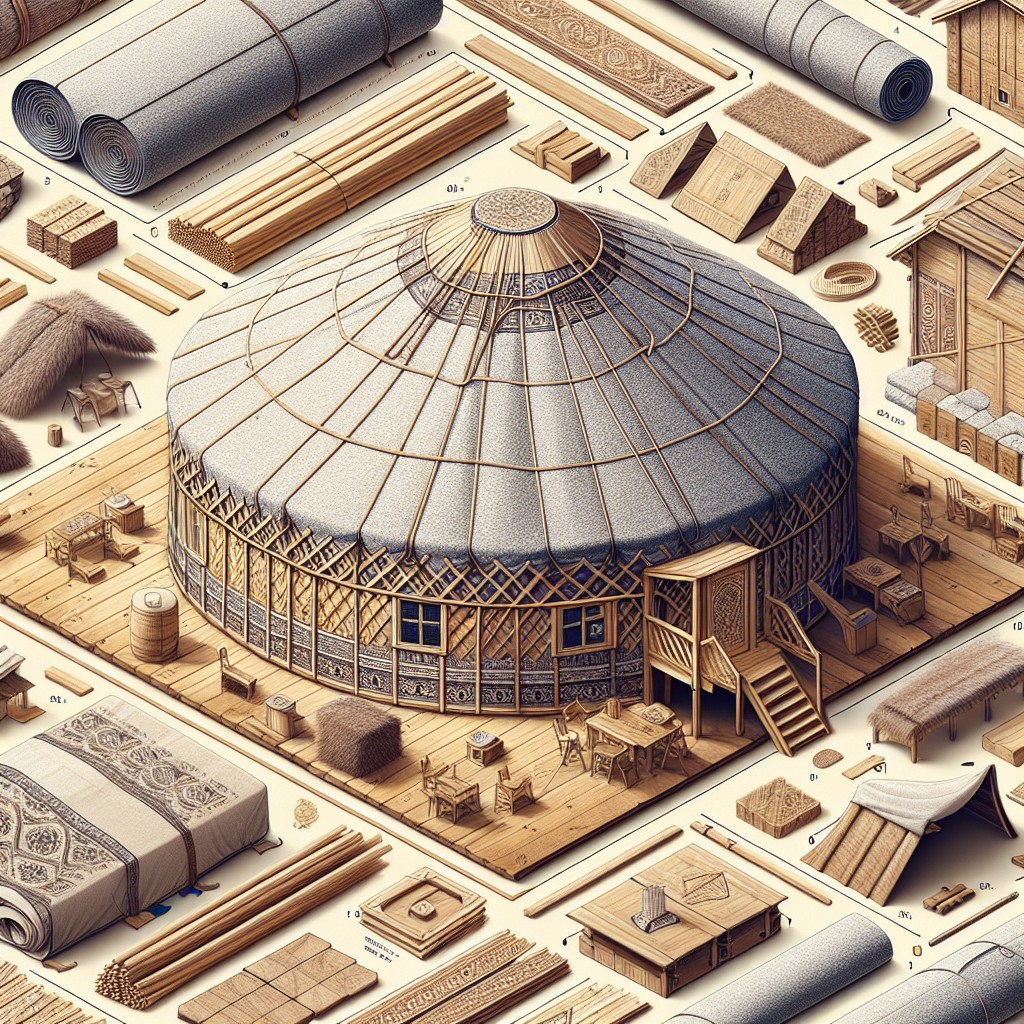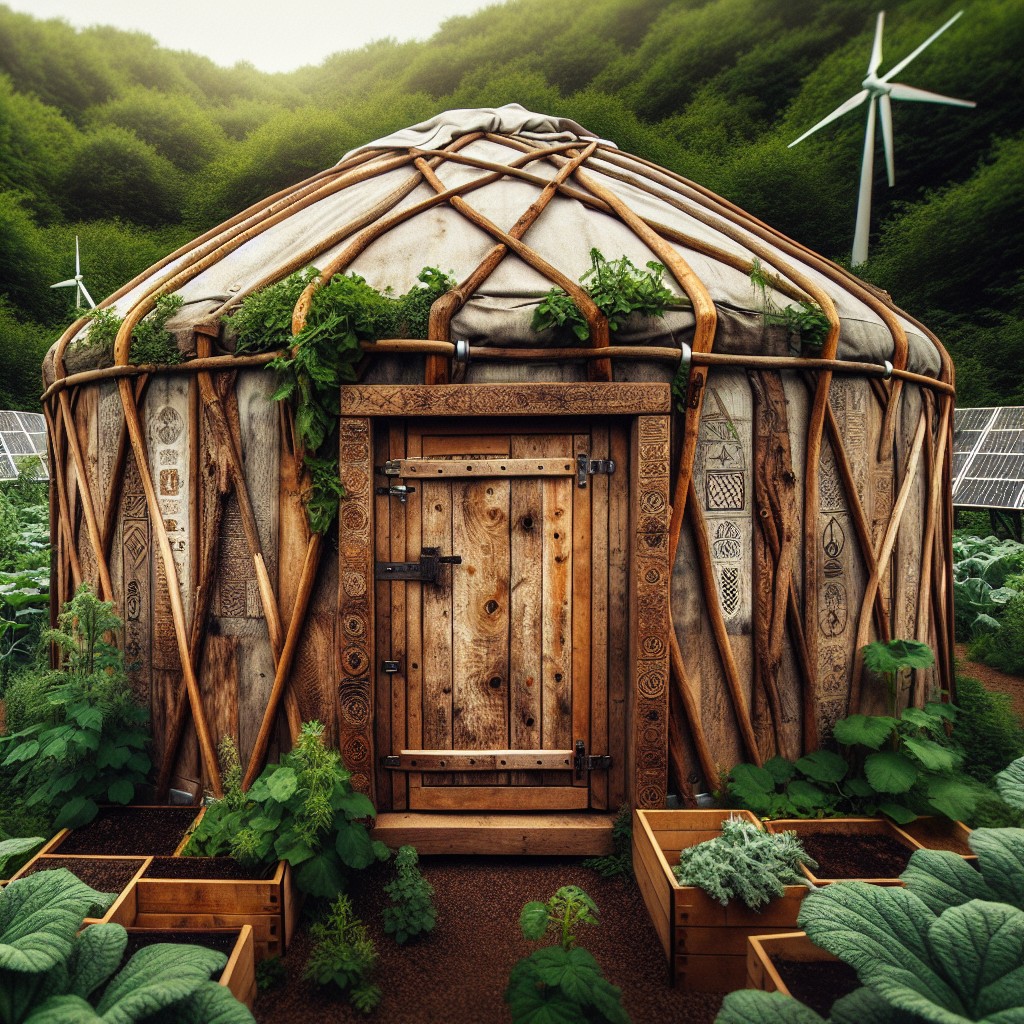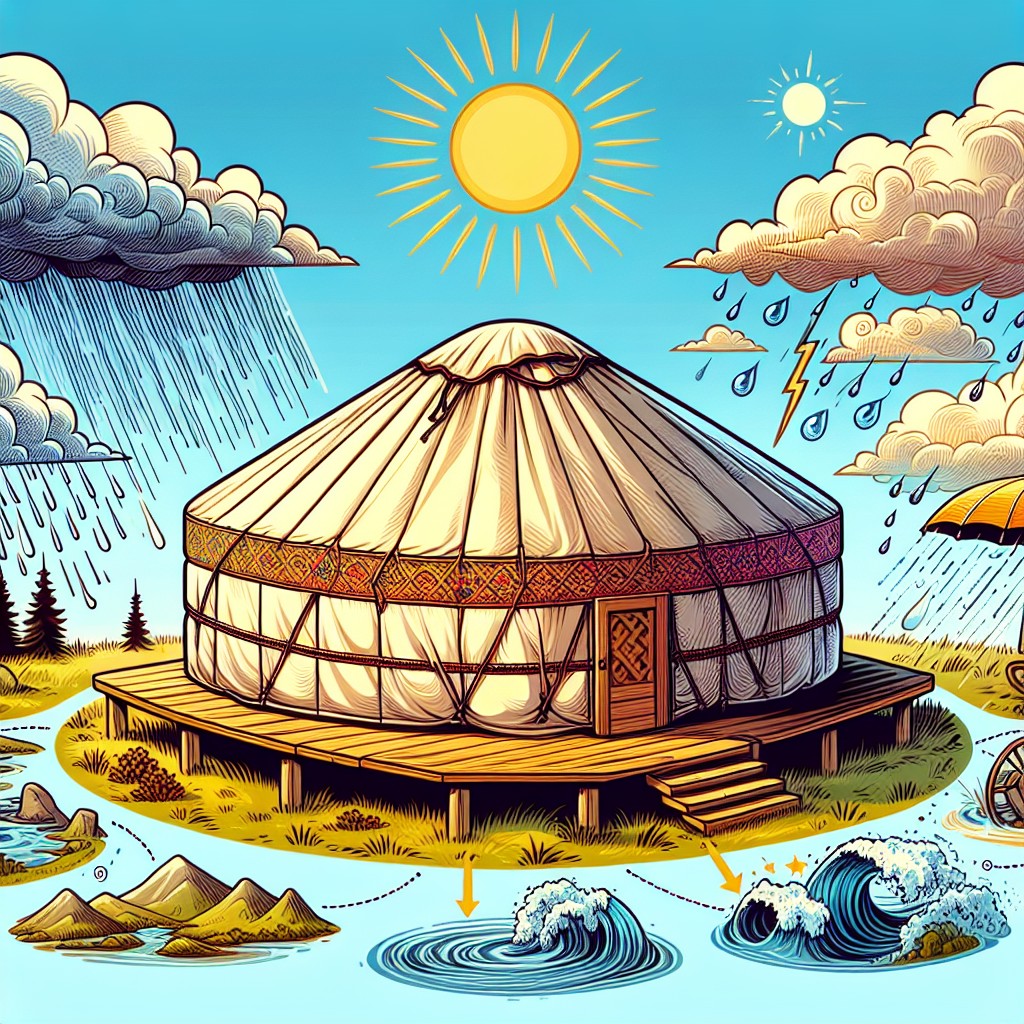Last updated on
Uncover why the durability of yurts goes beyond their simple and portable design, making them renewable housing options, because their lifespans can surprise you.
The lifespan of a yurt hinges hugely on the type of material used to construct it and the maintenance it receives. Traditionally made, felt-covered yurts can last around 8 to 15 years while modern versions with durable synthetic coverings can considerably outlast, providing shelter for up to 30 years or more.
Bear in mind, though, that every yurt, like any other structure, demands regular care and attention. Curious to know more about yurt’s longevity and maintenance? Stick around as this article is flush with invaluable details to prolong your yurt’s life.
Key takeaways:
- Yurt lifespan: Traditional yurts 8-15 years, modern yurts 30+ years
- Factors affecting yurt longevity: materials, climate, maintenance, usage
- Selecting durable materials: wood frame, weather-resistant coverings, insulation
- Wood frame durability: choose hardwoods, treatments against rot and pests
- Outer cover resistance: high-grade canvas, UV protection, reinforce seams and zippers
Factors Affecting Yurt Longevity

Understanding the elements that influence the lifespan of a yurt is crucial for prospective and current owners.
The quality of the materials used is paramount. High-grade canvas, architectural fabrics, or felt for the outer cover have different life expectancies. Similarly, the durability and treatment of the wooden frame components play a pivotal role in how well a yurt will stand the test of time.
Local climate conditions also hold sway over a yurt’s longevity. Heavy snow loads, fierce winds, and relentless exposure to UV can accelerate wear and tear. Yurts located in extreme environments often demand more robust construction and extra maintenance.
Maintenance frequency significantly impacts a yurt’s condition. Regular checks and timely repairs can prevent small issues from becoming major problems.
Lastly, how a yurt is utilized can result in varying degrees of wear. Full-time living quarters may experience more rapid degradation than a yurt used occasionally as a retreat or studio, necessitating a different approach to care and preservation.
Materials Used in Yurt Construction

Selecting the right materials is crucial for the durability and comfort of a yurt. Traditional yurts are built with natural materials like felt and horsehair, while modern versions often incorporate industrial fabrics and insulating materials.
Framework: Typically constructed from wood, the lattice wall and roof rafters form the skeleton of the yurt. Hardwoods like oak provide strength and longevity, while softwoods like cedar are chosen for their resistance to rot.
Coverings: The outer shell usually consists of canvas or polyester, which are weather-resistant and can include a UV protective coating. Quality covers are mold and mildew-resistant, essential for damp climates.
Insulation: To maintain a comfortable interior, layers of wool felt, reflective foils, or modern synthetic insulation can be used. The right choice insulates against heat loss in winter and keeps the yurt cool in summer.
Dome and Windows: Acrylic or polycarbonate materials are preferred for the dome skylight, offering resilience to impact and clear light transmission. Windows may feature similar materials or be constructed from durable vinyl with double glazing options.
By prioritizing sturdy materials adapted to your specific climate, you can ensure that your yurt stands strong against the elements for years to come.
Wood Frame Durability and Sustainability

Opting for high-quality, sustainably-sourced timber can significantly enhance the structural integrity and lifespan of your yurt’s wooden components. Hardwoods are known for their resilience and can withstand the test of time better than softer wood varieties. They are less prone to warping and damage, which is crucial for maintaining the yurt’s shape and stability.
To further increase the frame’s durability, treatments against rot, mold, and pests should be considered. These treatments help in preventing deterioration due to environmental factors, thereby extending the lifespan of the wood. It’s also worth noting that sustainably harvested wood not only supports the longevity of the yurt but also contributes positively to the environment by promoting responsible forestry practices.
Proper assembly is key to sustainability. Ensure that the wood frame is correctly installed, with tight joints and secure fittings, to prevent unnecessary stress that could lead to premature wear or damage.
Remember, the more attention you invest in selecting and maintaining your yurt’s wooden frame, the more years of enjoyment and shelter it can provide. Regular inspections for signs of damage or wear can help address any issues promptly, contributing to the overall sustainable living experience a yurt can offer.
Outer Covers Resistance to Elements

The resilience of a yurt’s outer cover is crucial in shielding against rain, snow, wind, and UV radiation. Typically, these covers are crafted from high-grade canvas or polyester with a protective coating to ward off water and prevent mildew growth.
For enhanced durability, look for materials treated for UV resistance, which helps prevent the cover from fading and deteriorating in sunlight. Reinforced seams and heavy-duty zippers thwart wind damage, essential for maintaining the yurt’s structural integrity.
In areas with heavy snowfall, select covers designed to bear the weight of snow accumulation. Remember, the longevity of the outer shell significantly depends on the quality of the material and the care it receives.
Regular cleaning, careful inspection for tears, and prompt repairs will aid in extending its service life.
Weatherproofing and Seasonal Challenges
Adapting to various climates, yurts need to withstand a range of weather conditions, from sweltering heat to bone-chilling cold. To maintain their integrity through the seasons, consider these points on how to enhance your yurt’s resiliency:
1. Insulation: Proper insulation maintains a comfortable interior temperature and reduces energy costs. Reflective insulation is particularly effective for keeping cool in summer and warm in winter.
2. Sealing: Check and seal any gaps around the doors, windows, and dome to prevent drafts and moisture ingress. This not only safeguards the structure but also improves energy efficiency.
3. Cover Condition: Regularly inspect the outer cover for signs of wear, such as fading or fraying, and treat it with waterproofing agents or repair patches to extend its lifespan.
4. Tent Platform: A sturdy, elevated platform can prevent water damage and infestations by critters that thrive in different seasons, ensuring a stable foundation year-round.
5. Snow Load Support: For yurts in snowy regions, reinforcement for the roof to handle accumulations is crucial, so ensure your structure is equipped to deal with the extra weight.
6. Awnings or Gutters: Adding protective features such as awnings can deflect rain and provide shade, while gutters direct water away from the base, further safeguarding the yurt from moisture-related issues.
Regular attention to these details will help your yurt face the challenges each season brings, preserving its charm and functionality for the long haul.
Dome Skylight Materials and Durability
Manufacturers typically construct dome skylights from durable plastics such as polycarbonate or acrylic, which are known for their resistance to impact and ultraviolet light. The materials chosen are critical to prevent yellowing and brittleness over time, ensuring that natural light continues to filter through efficiently.
The thickness of the plastic plays a key role in its durability; thicker materials can better withstand harsh weather conditions without cracking or breaking. Furthermore, quality seals and gaskets around the dome are indispensable for maintaining a watertight and insulated structure. It’s essential to periodically check these components for wear and tear to prevent leaks.
Advancements in glazing technology mean that many modern skylights come with coatings to enhance energy efficiency. These coatings can minimize heat loss in the winter and reduce heat gain in the summer, thus contributing to a comfortable yurt interior throughout the year.
Opting for a double-glazed skylight can further increase insulation and protection against the elements. While slightly more expensive, the added layer can extend the lifespan of the skylight and improve energy efficiency, making it a worthwhile investment for many yurt dwellers.
Regular cleaning to remove debris and prevent scratching is recommended for maintaining clarity and durability. With proper care, a high-quality dome skylight can last for decades, continuing to provide ample natural light and contributing to the yurt’s overall longevity.
Frequency of Maintenance Required
Proactive maintenance is key to extending the life of a yurt. Annual inspections should focus on the integrity of the fabric cover, checking for tears, mildew, or areas weakened by UV exposure.
Wooden components require a biennial application of sealant or wood preservative to ward off rot and insect damage.
Addressing any issues with the dome skylight, like cracks or leaks, will prevent moisture from seeping in.
Maintaining a clear perimeter around the yurt helps to avoid moisture buildup and animal intrusion.
Finally, keeping the interior dry and well-ventilated reduces the potential for mold growth and structural damage from condensation.
Location and Weather Influences On Yurt Longevity
Selecting the optimal site is crucial for maximizing a yurt’s lifespan. Consider these points regarding how location and weather impact a yurt’s durability.
- Elevation and Exposure: At higher altitudes, yurts face stronger UV rays and potential for wind damage. Lower elevations may mean increased humidity and risk of mildew.
- Wind Patterns: Areas with high wind velocities require yurts to be anchored securely and may necessitate thicker cover materials to withstand the force.
- Precipitation: Heavy rain or snowfall demands a well-angled roof to facilitate runoff and prevent water pooling, which can lead to cover deterioration.
- Temperature Extremes: In areas with significant temperature fluctuations, insulation becomes a priority to prevent material fatigue caused by expansion and contraction.
- Sun Exposure: Constant direct sunlight can degrade fabric covers over time, hence UV-resistant materials are critical in sunny locales.
Siting a yurt with these considerations in mind can prevent premature wear and extend its useful life.
Use and Occupancy Considerations
How you utilize your yurt can have a significant impact on its lifespan. A yurt that’s occupied year-round will endure more wear and tear compared to one used seasonally or occasionally. Here are a few considerations to keep in mind:
- Residential vs. Recreational Use: Full-time living can accelerate the aging process of interior materials due to constant exposure to moisture, heat, and movement. Recreationally used yurts may experience less strain.
- Foot Traffic: High traffic can lead to quicker wear of flooring and ground coverings. Consider durable flooring options and using mats at entrances to minimize dirt and abrasion.
- Ventilation: Proper air circulation is crucial for preventing mold and mildew. Ensure your yurt has adequate ventilation, especially if used for activities that generate moisture, like cooking or showering.
- Insulation: Adequate insulation is a must for full-time occupancy, particularly in extreme climates, to reduce stress on the yurt’s heating and cooling systems.
- Furniture and Fixtures: Heavy furniture and fixtures can stress the yurt’s structure. Opt for lightweight, space-saving designs that complement the yurt’s circular configuration.
- Cleaning and Upkeep: Regular cleaning and upkeep reduce the risk of damage and add to the yurt’s longevity. This includes checking for leaks, cleaning the fabric, and inspecting for pests.
Understanding and adjusting to these use and occupancy factors can prolong the comfortable and functional life of your yurt.
Protecting the Yurt From Environmental Damage
Maximizing your yurt’s defense against the elements extends its lifespan and ensures a comfortable living space. Here are strategic approaches to shield your structure from environmental threats:
1. Apply protective coatings: Regularly treat wood components with sealants to prevent moisture damage and decay. For yurts with canvas or fabric covers, use waterproofing sprays to repel water and protect against mildew.
2. Position with care: Choose a location that provides natural shelter from harsh weather, such as windbreaks, to reduce the impact of strong gusts and storms.
3. Strategic landscaping: Plant vegetation to absorb excess moisture and anchor the soil around your yurt. Avoid trees that could pose a risk of falling branches.
4. Snow and rain management: Ensure adequate drainage around your yurt. Steeper roof angles allow snow to slide off, reducing the weight burden and the risk of water ingress.
5. Insect and rodent prevention: Seal potential entry points and use natural repellents to deter critters from causing damage to your yurt’s structure and interior.
6. Shade solutions: In areas with intense sun, use reflective materials or deploy exterior shades to prevent UV damage to the exterior surface and keep the interior cool.
By integrating these protective measures, you’re actively contributing to the durability and resilience of your yurt, regardless of what Mother Nature throws your way.
Repair and Replacement: Planning for Longevity
To enhance the lifespan of your yurt, it’s crucial to approach repairs and replacements proactively:
- Identify wear and tear early: Regular inspections help catch issues before they escalate, such as small tears in the fabric or cracks in the wood.
- Use quality replacement parts: Opt for durable materials when replacing components to maintain structural integrity.
- Schedule timely repairs: Addressing minor damage promptly avoids larger, more costly repairs in the future.
- Learn simple repair techniques: Acquire skills to fix minor problems, like patching the outer cover, to save time and money.
- Collaborate with professionals: Seek expert help for complex repairs to ensure they are done correctly and safely.
By being vigilant and taking action when necessary, you can maintain your yurt’s condition and stretch its usable life significantly.
The Effect of Customizations On Yurt Longevity
Customizing your yurt can enhance its comfort and functionality, but it may also impact how long it lasts. Thoughtful design choices can strengthen the structure, while others might introduce vulnerabilities.
- Windows and Doors: More windows and doors can provide better ventilation and natural light but may compromise the yurt’s insulation and structural rigidity. Ensure professional installation to maintain integrity.
- Insulation Upgrades: High-quality, properly installed insulation can protect against extreme temperatures, potentially extending the yurt’s life by reducing material wear.
- Flooring Options: Installing durable flooring can guard against wear and tear from heavy use, contributing to the overall longevity of the structure.
- High-Tech Features: Adding modern conveniences such as solar panels or climate control systems should be done carefully to avoid roof overloading or wall damage.
Each customization should be carefully evaluated for its impact on the yurt’s durability, always considering professional installation and the best materials your budget allows.
Common Myths About Yurt Durability Debunked
Yurts are often considered temporary structures, but with proper care, they can be remarkably enduring. The misconception that yurts are fragile and easily damaged is one of the myths surrounding their durability. In reality, modern yurts are designed to withstand harsh conditions including strong winds and heavy snow loads, dispelling the belief that they’re unsuitable for extreme weather.
Another common myth is that yurts are prone to mold and mildew. While natural materials like canvas can be susceptible if not maintained, many yurts now use advanced synthetic materials that resist moisture and inhibit mold growth, ensuring a healthier living environment.
The belief that yurts cannot be secured is also unfounded. Yurts can be equipped with lockable doors and windows, just like conventional homes, providing security against intruders. Plus, the circular design offers no hidden corners for a potential break-in, adding an element of natural surveillance.
Lastly, there’s the misconception that yurts are not energy efficient. In fact, the circular shape of a yurt promotes efficient air circulation, and when combined with proper insulation and heating sources, a yurt can be as energy-efficient as a traditionally-built home.
Prolonging the Lifespan of Your Yurt
Maximize the life of your yurt by adopting these actionable strategies:
– Schedule routine inspections: Check your yurt periodically, especially the roof and walls, for any signs of damage or wear. – Address repairs promptly: Tackle any issues immediately to prevent minor damages from escalating. – Sealant application: Apply high-quality sealants to the wooden components to fend off moisture and decay. – Protective coatings: Use UV-resistant treatments on the fabric cover to reduce sun damage. – Proper ventilation: Ensure good airflow to curb mold and mildew growth, critical in humid climates. – Snow and debris removal: Keep the roof clear to prevent structural strain caused by excess weight. – Pest control measures: Deter insects and rodents that might gnaw on or nest in the yurt materials. – Off-season care: If not used year-round, store the fabric and dismantle the frame properly during the off-season for preservation. – Owner education: Understand the specific needs of your yurt’s materials and environmentally tune your maintenance accordingly.Implementing these practices contributes to a resilient and enduring yurt, ready to stand the test of time.
Purchasing Quality Yurt Components
Opting for quality components is crucial in maximizing your yurt’s lifespan. Select materials known for their resilience:
- For the frame, choose dense wood varieties such as Douglas fir or cedar, which resist rot and insect damage.
- Invest in high-grade, UV-resistant fabrics for the outer cover that can fend off sun degradation.
- Acrylic or polycarbonate for the dome skylight can ensure longevity and better withstand harsh weather.
- Durable, heavy-duty sealing products can help prevent water ingress at critical joining points.
- Look for strong, corrosion-resistant fasteners and anchors to maintain structural integrity.
When purchasing, consider suppliers with excellent reputations for material quality and customer service. High-quality components might come with a higher upfront cost but will offer greater durability and lower maintenance costs over time.
Regular Care and Maintenance Best Practices
Ensuring your yurt remains a durable and comfortable living space requires regular upkeep. Adhere to these maintenance best practices to promote longevity:
- Inspect the Cover: Twice a year, check for tears or areas of excessive wear. Promptly patch minor damage to prevent moisture seepage.
- Clean the Canvas: Use mild soapy water to clean the yurt’s exterior. Avoid harsh chemicals, which can degrade fabric and shorten the lifespan of the cover.
- Monitor the Dome Skylight: Keep it clear of debris and condensation to preserve visibility and light transmission.
- Seal the Wood: Every few years, treat the frame with a suitable sealant to protect against moisture and insects.
- Check for Mold: Look for signs of mold or mildew, particularly in hidden nooks and crannies, and treat immediately with appropriate eco-friendly products.
- Tighten Cables: Annual tension adjustments maintain structural integrity, especially after harsh weather conditions.
- Review Seams and Edges: Ensure that seams remain sealed and edges are tucked and secure to prevent wind or water ingress.
Remember, a little prevention goes a long way in extending the life and beauty of your yurt.
Yurt Longevity: Real-Life Stories
Hearing from those who have lived in a yurt year-round provides valuable insights into their real-world durability:
- A family in Montana has been cozying up in their yurt for over a decade, crediting a strict maintenance routine and prompt repairs for its longevity.
- In Washington state, a couple reports their yurt remained resilient for 15 years until they needed to replace the outer cover due to UV damage.
- A yurt enthusiast in Colorado experienced how high-altitude UV rays can shorten a yurt’s lifespan; they found that protective sealants could double the life of the wooden components.
- Owners in rainy climates, like Oregon, often share stories of how regular application of mold-resistant treatments on canvas extends the life of their yurts.
- Community stories from coastal regions highlight the importance of rust-resistant metals for structural integrity in salty, humid air.
These experiences collectively suggest that with proper care, attention to local environmental factors, and timely intervention, yurts can provide a durable, sustainable housing solution for many years.
FAQ
What are the disadvantages of a yurt?
The main disadvantages of a yurt include limited storage and living space, along with potential challenges in implementing plumbing and electrical systems.
Are yurts high maintenance?
No, yurts are not high maintenance; they are relatively low-maintenance structures, requiring only some simple upkeep steps to maintain their aesthetics and performance.
How durable are yurts?
Yurts are highly durable, largely due to their wood frame that, similar to other wood structures, is built using quality lumber with no specific "wear out" date, and their components such as dome, doors, and fabric walls and roof are replaceable over time.
Do yurts leak in the rain?
Yurts can leak during periods of high rainfall, with water seeping in from under the tent and sometimes driving through the sides and roof, so it’s recommended to keep belongings off the floor.
Can yurts withstand heavy snowfall or extreme weather conditions?
Yes, yurts can withstand heavy snowfall and extreme weather conditions when designed with appropriate structural reinforcements and insulating materials.
How effective is a yurt’s insulation compared to traditional homes?
Yurts can be effectively insulated, comparable to traditional homes, with proper modifications such as double-layered walls and additional insulation materials.
What are the necessary steps to preserve a yurt’s lifespan?
To preserve a yurt’s lifespan, regular maintenance including checking and tightening the tension bands, cleaning the cover, checking for mold or mildew, and protecting the wooden parts from insects and moisture is necessary.
Table of Contents




